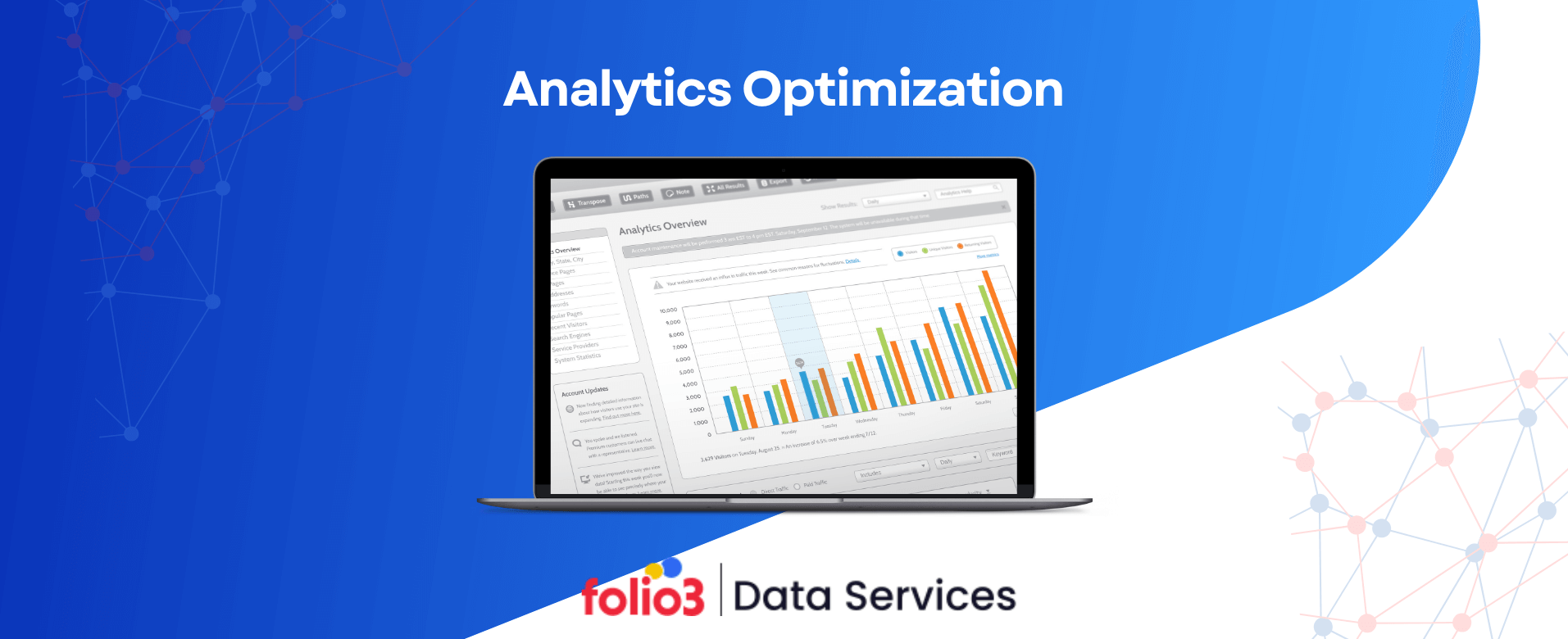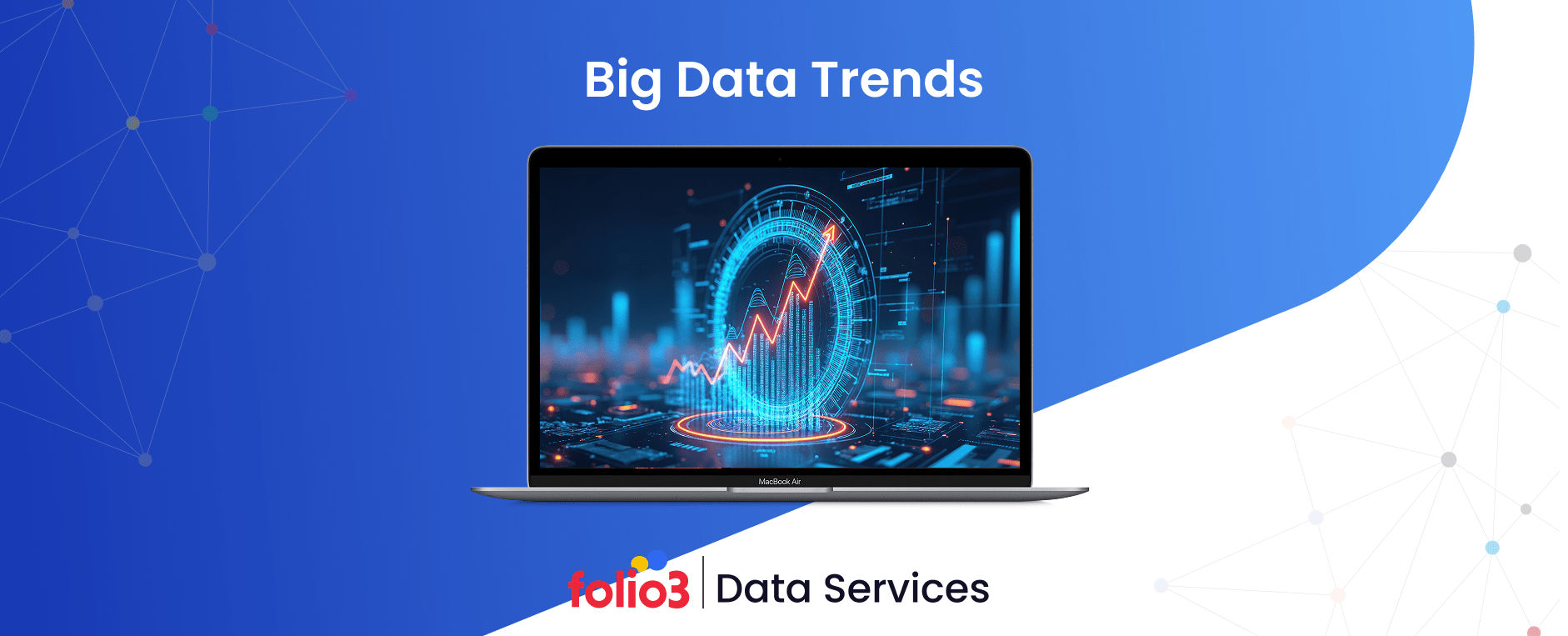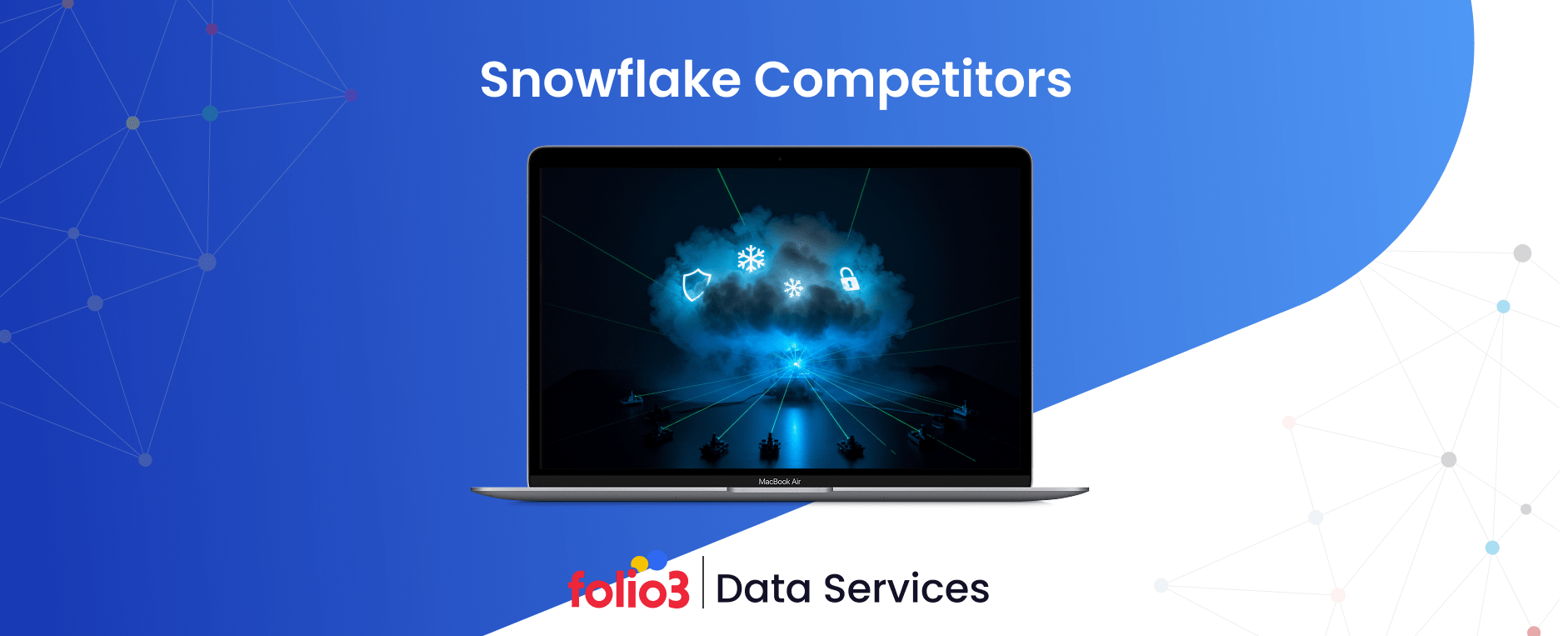In an industry where data drives every critical business decision, the ability to effectively analyze and optimize that data has become a game-changer. Analytics optimization in data refers to refining analytics systems and practices to ensure businesses extract the most actionable insights possible. Companies can gain a competitive edge in their industries by enhancing data quality, improving tools, and aligning analytics strategies with business goals.
Why is analytics optimization essential? The answer lies in the growing need for agility and precision in decision-making. Whether improving customer experiences, forecasting market trends, or enhancing operational workflows, optimized analytics empowers organizations to remain competitive in a dynamic market.
This process involves refining data analysis frameworks and implementing systems that align with business goals for sustained success. This blog dives into why analytics optimization is vital for businesses, its benefits, and actionable steps to implement it for lasting success.
Key Components of Analytics Optimization
Combining data analytics and optimization techniques can help businesses achieve operational excellence and gain a competitive edge. This blog delves into the core components of analytics optimization, explores its benefits, and provides actionable steps to help organizations optimize data for unparalleled success.
Key components of analytics optimization play a crucial role in achieving this:
- Data Quality Management ensures data accuracy, consistency, and completeness, forming a solid foundation for actionable insights. Even the most advanced analytical tools can only deliver meaningful results with clean and reliable data.
- Performance Metrics and KPIs provide a clear roadmap for measuring success. Identifying the right performance indicators allows businesses to track progress, assess alignment with goals, and continuously improve operations.
- Advanced Analytical Tools and Techniques unlock deeper insights by leveraging machine learning, predictive analytics, and data visualization platforms. These tools not only enhance decision-making but also uncover trends that were previously hidden in complex datasets.
Best Practices for Effective Analytics Optimization
Achieving excellence in analytics optimization requires a structured approach integrating strategy, technology, data analytics consulting, and collaboration. By adopting best practices, organizations can ensure their analytics efforts yield actionable insights and drive meaningful results.
Here are the most effective strategies to optimize data and enhance analytics performance:
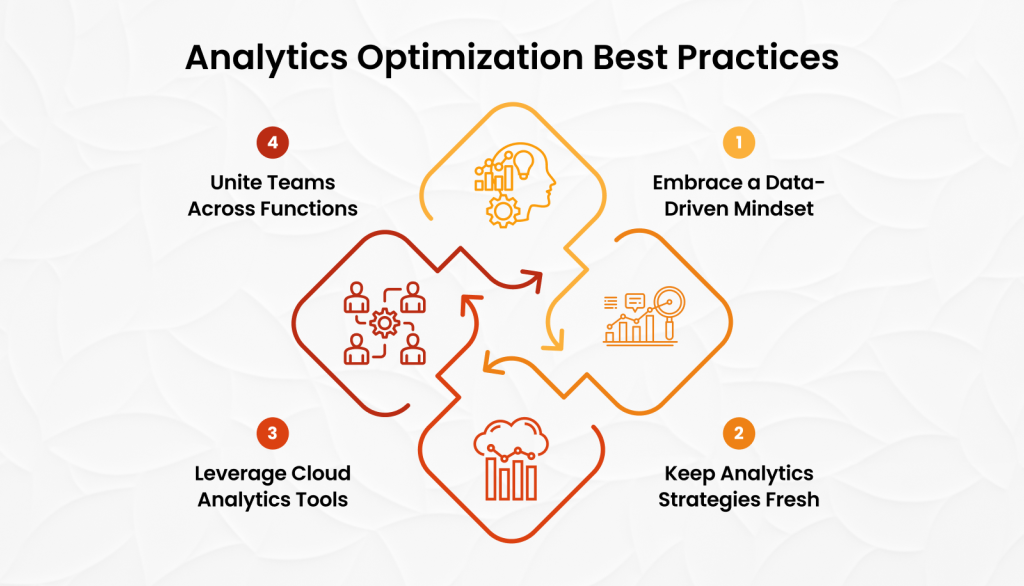
1. Fostering a Data-Driven Culture
Organizations must embed data-driven decision-making into their culture to unlock the true potential of data analytics and optimization. This means shifting from intuition-based decisions to those grounded in data insights. Achieving this requires:
- Employee Training: Equip employees with the skills to interpret and leverage analytics effectively. This ensures that data becomes an integral part of daily workflows.
- Integration in Workflows: Seamlessly incorporating analytics tools into everyday operations helps employees rely on data for strategic and operational decisions.
A data-driven culture empowers teams to make smarter, faster decisions and aligns analytics efforts with overall business objectives.
2. Regularly Reviewing and Updating Analytics Strategies
The business world is dynamic, with shifting customer preferences, market trends, and competitive landscapes. Analytics frameworks that remain static risk becoming obsolete. To maintain the relevance and effectiveness of optimization analytics initiatives:
- Periodically audit your analytics framework to identify outdated tools, techniques, or metrics.
- Update key performance indicators (KPIs) to reflect current business goals.
- Use advanced tools for emerging analytics trends, such as machine learning or predictive analytics, to stay ahead of competitors.
Continuous updates to data analytics strategies ensure businesses remain agile and responsive to change.
3. Using Cloud-Based Analytics Platforms
Cloud-based platforms have transformed how organizations manage and analyze data. Tools such as Google Analytics, Tableau, and Power BI provide scalable, cost-effective solutions for businesses looking to enhance their data analytics and optimization capabilities.
Key benefits of cloud platforms include:
- Real-Time Access: Gain insights on-demand from anywhere, enabling quicker decision-making.
- Scalability: Easily handle increasing volumes of data without the need for substantial infrastructure investments.
- Cost Efficiency: Reduce expenses associated with maintaining on-premises systems while benefiting from advanced analytics features.
By embracing cloud platforms, organizations can modernize their analytics infrastructure and gain a competitive edge.
4. Building Cross-Functional Teams
Collaboration between technical teams (data scientists, IT professionals) and business units is critical for successful analytics optimization. Cross-functional teams help bridge the gap between technical expertise and business needs, ensuring that analytics initiatives drive meaningful outcomes.
- Shared Goals: Align analytics projects with organizational objectives by fostering department collaboration.
- Knowledge Sharing: Enable technical teams to translate complex data into actionable insights while business teams provide context and define priorities.
Building these bridges ensures that analytics efforts are balanced and integrated into the larger business strategy.
The Process of Analytics Optimization
Analytics optimization is not a one-time task but a continuous journey of refinement and improvement. A structured approach ensures businesses can maximize the value of their data and analytics systems.
Here’s a detailed breakdown of the process:
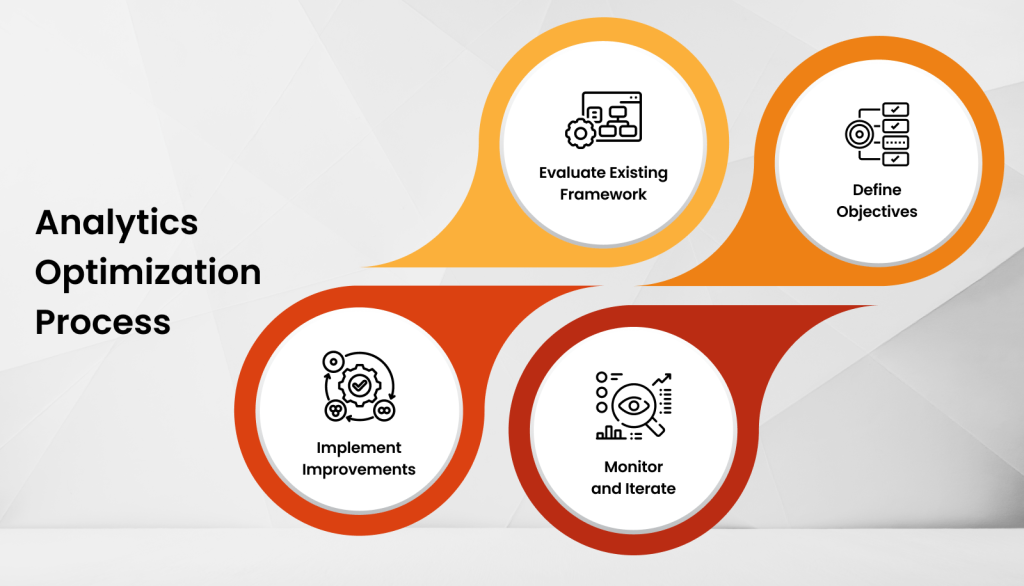
1. Evaluate Existing Analytics Framework
Before making improvements, organizations need to understand their current analytics landscape. This step involves a thorough audit of the following:
- Tools and Technologies: Assess the performance and relevance of existing analytics platforms. Are they meeting the organization’s needs?
- Processes: Evaluate workflows related to data collection, processing, and reporting. Identify inefficiencies or bottlenecks.
- Data Sources: Ensure data inputs are reliable, diverse, and complete. Gaps or consistency in data quality can help optimization efforts.
This evaluation lays the foundation for improvements in targeted data analytics and optimization strategy. Data strategy consultants are often brought in at this stage to provide an objective assessment and help define best practices.
2. Define Objectives
Once gaps are identified, set clear, measurable objectives that align with organizational goals. Examples of objectives include:
- Reducing Costs: Optimizing supply chain operations or automating manual analytics tasks to improve efficiency.
- Improving Customer Satisfaction: Using customer behavior analytics to tailor services and enhance user experiences.
- Increasing Revenue: Leveraging predictive analytics to identify new market opportunities or optimize pricing strategies.
Having defined objectives ensures that optimization analytics efforts are focused and results-driven.
3. Implement Improvements
Implement targeted improvements to enhance the analytics framework based on the evaluation and objectives. These may include:
- Introducing New Tools: Upgrade to advanced analytics tools like Tableau, Power BI, or predictive modeling platforms to unlock deeper insights.
- Refining Data Collection: Automate data pipelines and ensure data accuracy through enhanced quality checks.
- Adjusting KPIs: Align key performance indicators with newly defined objectives to track the right metrics.
The goal is to optimize data workflows and make analytics more robust and effective.
4. Monitor and Iterate
Analytics optimization is an ongoing process that requires regular monitoring and adjustments. To stay ahead of challenges and opportunities:
- Track Performance: Continuously monitor the effectiveness of analytics tools, strategies, and KPIs. Comparing internal results with industry-wide data analytics stats helps gauge whether your performance aligns with market trends and best practices.
- Incorporate Feedback: Use insights from stakeholders to refine processes and address new business needs.
- Adapt to Change: Stay agile by adopting emerging technologies and methodologies as the business landscape evolves. This iterative approach ensures that analytics remains a dynamic, powerful tool for business growth.
Use Cases of Successful Analytics Optimization
Analytics optimization has transformative potential across various industries. It enables businesses to harness data more effectively to achieve operational excellence, enhance customer experiences, and drive innovation.
These real-world case studies highlight how industries like energy, automotive, and e-learning have unlocked the full potential of analytics optimization through tailored solutions by Folio3 Cloud and Data. Whether enhancing operational efficiency, delivering real-time insights, or scaling data platforms, the results speak to the power of data-driven transformation.
Below are examples from industries where Folio3’s Cloud and Data solutions have been instrumental:
1. Energy and Utilities – Optimizing Big Data Analytics for Schlumberger (Oil & Gas)
Scenario
Tackling Big Data integration and scalability in offshore drilling operations.
Industry Impact
- Customer Behavior Analysis: Leveraging real-time insights to optimize drilling processes and reduce environmental risks.
- Supply Chain Optimization: Streamlining logistics and operations by analyzing data from multiple sources.
Key Achievements with Folio3
- Real-time analytics for immediate decision-making.
- Scalable cloud-based solutions to manage and integrate massive datasets using Microsoft Azure.
- Enhanced data consistency and reduced operational inefficiencies through AI/ML transformations and CI/CD pipelines.
2. Automotive – Real-Time Communication in Connected Vehicles for Aiden
Scenario
Enabling vehicles to share real-time data securely for safer and more efficient driving.
Industry Impact
- Predictive Maintenance: Real-time alerts for vehicle health and maintenance needs.
- Traffic Analysis: Improving road safety by leveraging IoT data to detect anomalies and optimize traffic patterns.
Key Achievements with Folio3
- Developed a cloud-based data platform with AWS, enabling secure, real-time data sharing using AWS Lambda and Kinesis.
- Enhanced vehicle communication through AWS IoT Core, ensuring seamless data processing and compliance with privacy standards.
- Scalable infrastructure to support increased data volumes, enhancing reliability and performance.
3. E-Learning – Data-Driven Educational Solutions for Summit K12
Scenario
Processing and analyzing massive datasets to revolutionize e-learning analytics.
Industry Impact
- Customer Behavior Analysis: Understanding student performance trends and learning patterns.
- Real-Time Data Integration: Optimizing content delivery and user engagement through personalized dashboards.
Key Achievements with Folio3
- Implemented advanced big data analytics using AWS Redshift and Apache Spark for real-time processing.
- Reduced report generation times from minutes to milliseconds, enabling responsive educational insights.
- Achieved seamless integration with over 10 third-party data sources to enhance analytics capabilities.
Tools and Technologies for Analytics Optimization
Businesses rely on powerful analytics tools to extract actionable insights, optimize performance, and gain a competitive edge. Using the right tools for analytics optimization can dramatically improve decision-making processes, operational efficiencies, and profitability.
Below, we explore some of the most prominent tools that help organizations in data analytics and optimization:
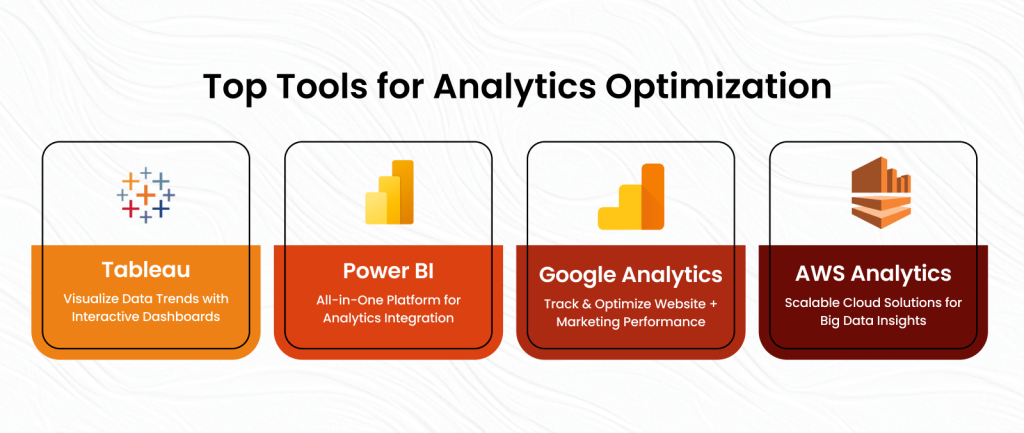
1. Tableau: Interactive Dashboards for Data Trends Visualization
Tableau is one of the leading analytics optimization tools known for its ability to create interactive and visually appealing dashboards. This powerful tool helps organizations visualize data trends in real time, enabling businesses to monitor performance, track KPIs, and make data-driven decisions efficiently.
With Tableau’s intuitive drag-and-drop interface, users can build custom dashboards that help optimize data across different departments, such as marketing, sales, and operations. Tableau is widely adopted as part of comprehensive business data analytics solutions, ensuring that insights are always up-to-date and tailored to the organization’s specific needs.
Key Benefits
- Real-time data visualizations and trend analysis.
- Easy integration with multiple data sources.
- Customizable dashboards that support in-depth data exploration.
- Enhanced decision-making through interactive and shareable reports.
2. Power BI – Comprehensive Analytics Integration
Microsoft’s Power BI product stands out as one of the most comprehensive tools for data analytics and optimization. With its strong integration capabilities and support from data integration consulting, Power BI can pull data from various sources, including cloud-based storage, Excel files, and databases, to create a unified analytics environment.
Data optimization is further enhanced by its AI-powered capabilities, which allow users to perform advanced analytics and predictive modeling. Using Power BI, businesses can optimize data to uncover hidden insights, track performance over time, and make proactive decisions that lead to continuous improvement.
Key Benefits
- Integrates seamlessly with a wide variety of data sources.
- Advanced analytics tools for in-depth data exploration.
- Real-time monitoring and reporting features.
- AI and machine learning capabilities to predict future trends and behaviors.
3. Google Analytics – Optimize Website and Marketing Performance
Google Analytics is a fundamental tool for businesses focused on optimization analytics, especially in terms of tracking and optimizing website and marketing performance. As an industry-standard tool, it provides detailed reports on user behavior, traffic sources, conversion rates, and other key performance indicators (KPIs).
Google Analytics offers invaluable insights into which marketing campaigns are most effective, how customers engage with your website, and where improvements are needed. Businesses can use these insights to optimize data to increase conversions, enhance user experience, and refine marketing strategies for maximum impact.
Key Benefits
- Tracks website performance and user behavior in real time.
- Provides insights into traffic sources and customer demographics.
- Measures conversion rates and optimizes the customer journey.
- Helps refine marketing strategies through data-driven insights.
4. AWS Analytics – Scalable, Cloud-Based Solutions for Big Data
Amazon Web Services (AWS) offers a suite of cloud-based tools for data analytics and optimization designed to handle the needs of big data environments.
With tools like AWS Redshift, AWS Glue, and Amazon Kinesis, businesses can scale their data analytics capabilities to meet growing demands while ensuring flexibility, security, and cost-effectiveness. When combined with big data engineering services, AWS analytics solutions enable enterprises to design efficient data pipelines, integrate diverse sources, and unlock real-time insights from massive datasets. AWS analytics is particularly valuable for organizations aiming to optimize large datasets and perform advanced analytics in real time.
Key Benefits
- Scalable solutions that grow with your business needs.
- Real-time analytics capabilities for immediate insights.
- High-performance data processing, storage, and analysis.
- Cost-efficient infrastructure with pay-as-you-go pricing models.
Conclusion
Analytics optimization is essential for businesses seeking to gain deeper insights, make smarter decisions, and stay ahead in a competitive landscape. By using advanced tools and strategies, companies can enhance their decision-making processes and operational efficiencies.
As businesses continue to adopt analytics optimization, the integration of technologies like Tableau, Power BI, Google Analytics, and AWS can unlock powerful capabilities. For those looking to further improve their data-driven initiatives, Folio3’s data services offer tailored solutions to optimize data analytics, streamline processes, and ensure scalability.
